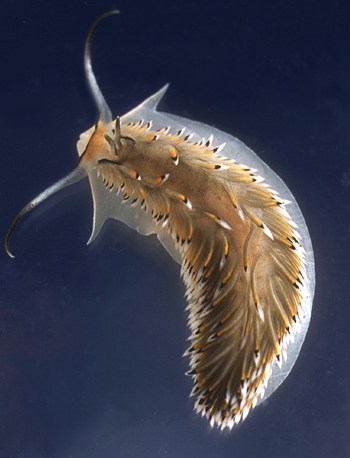
Cerberilla asamusiensis
Baba, 1940
Order: NUDIBRANCHIA
Suborder: AEOLIDINA
Family: Aeolidiidae
PHOTO
Toyama, Toyama Bay, Japan. 30-40mm length. 3 July 2002. Photo courtesy of the Takaoka Biological Club, Japan.
This species has similarities to Cerberilla annulata in colour but in that species the yellow and black bands on the cerata are bands of regular width and outlined in white. In C. asamusiensis the yellow-orange region covers a broad section of the upper ceras and the black region is cap-shaped. It also differs in the blackinsh rhinophres and the black line that runs across the front of the head and along the front edge of the oral tentcales to join the black upper half of the oral tentacles.
References:
• Baba, K. (1940) Some additions to the nudibranch fauna of the northern part of Japan. Bulletin Biogeographical Society of Japan, 10(6): 103-111.
• Baba, K. (1976) The genus Cerberilla of Japan (Nudibranchia: Eolidoidea: Aeolidiidae), with the description of a new species. The Veliger, 18(3): 272-280.
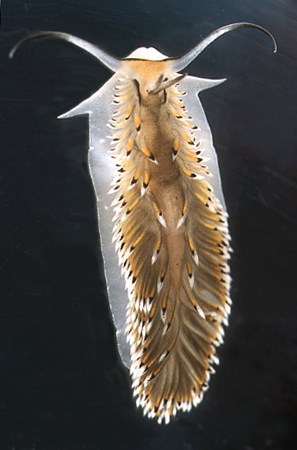
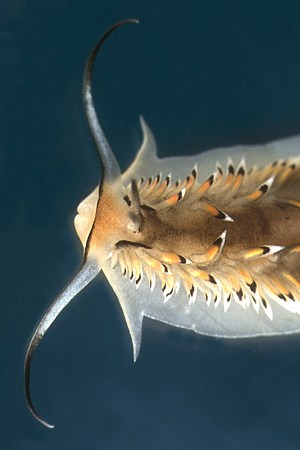
Rudman, W.B., 2002 (July 11) Cerberilla asamusiensis Baba, 1940. [In] Sea Slug Forum. Australian Museum, Sydney. Available from http://www.seaslugforum.net/find/cerbasam
Related messages
Cerberilla asamusiensis from sthrn Queensland
September 4, 2009
From: Gary Cobb

Concerning message #7457:
Hi Bill and everyone!
Great to see you're back in the Nudibranch Saddle! I wish to present to the Forum a species I find pretty incredible.
While sieving the white sand off the shore of Bulwer Beach, Moreton Island in about 4 m of water, I "uncovered" Cerberilla asamusiensis!
Locality: Bulwer Beach, Moreton Island, 4 m, Queensland Australia, Pacific Ocean, 12 July 2009, Subtidal. Length: 23 mm. Photographer: Gary Cobb and David Mullins
Got the animal onto the boat where it started immediately laying eegs. I have included a closeup photo of the eggs and they appear to be dividing after only 2 hours. Can this be? Is it possible the egg is born in multiple yokes?
I have also included a closeup of the cerata. The digestive organ is clearly visible.
This species has the widest foot I have seen.
Cheers
Gary
gary@nudibranch.com.au

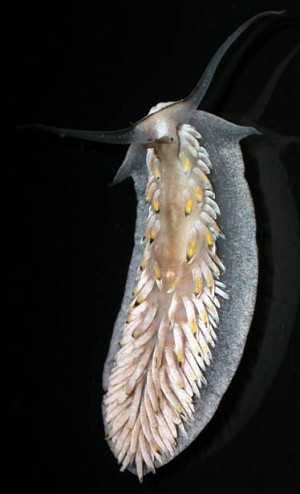

Dear Gary,
This is an interesting find. It certainly looks like C. asamusiensis, which would make this a huge range extension from Japan. The egg ribbon is also very interesting as we have little information on the biology of any species of these sand-dwelling aeolids. Looking at the eggs, some seem seem to have divided past the 4 cell stage so I am pretty sure this is egg division rather than cluster of 4 discrete eggs in each capsule. Not all nudibranchs lay their eggs at the single cell stage. I have observed some species of Pupa, such as Pupa kirki, delaying laying until the eggs were just about to 'hatch' as free -swiming veliger larvae. I guess if you are a sand-dweller and it is difficult to find 'safe' permanent structures to stick your egg ribbon to, there is an advantage in keeping the eggs until they are a late embryo. In this way they are less likely to be washed away from their preferred habitat.
Best wishes,
Bill Rudman
Re: Cerberilla asamusiensis from the Japan Sea
July 22, 2002
From: Shigeru Hayashi
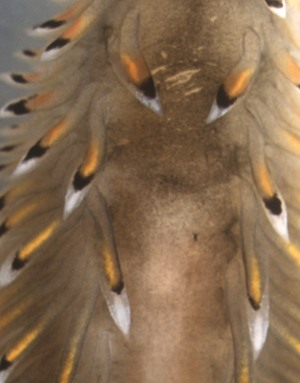
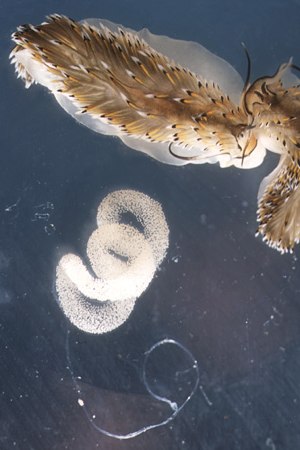
Dear Bill,
Here is a photo to answer your question about the colour of the cerata in this species. As you thought, the black and yellow colours in the cerata of Cerberilla asamusiensis are in the digestive gland duct. I checked with a microscope.
I have also sent a photo of its egg mass.
Photos - Courtesy Takaoka Biological Club, Japan.
Sincerely yours
Shigeru Hayashi
jr9dsx@tko.fitweb.or.jp
Hayashi, S., 2002 (Jul 22) Re: Cerberilla asamusiensis from the Japan Sea. [Message in] Sea Slug Forum. Australian Museum, Sydney. Available from http://www.seaslugforum.net/find/7562Dear Shigeru,
Thanks for checking the colour for me. Thanks also for the egg mass photo. As well as having long oral tentacles and a very broad foot as adaptations for living in the sand, it also has a long string or thread on the end of its egg ribbon. It ises this thread to anchor the egg ribbon in the sand by attaching it to a large rock or shell, or to the rock layer under the sand. Many sand dwellers,such as the aglajids, have a similar long thread on their egg masses.
Best wishes,
Bill Rudman
Cerberilla asamusiensis from The Japan Sea
July 13, 2002
From: Shigeru Hayashi

Dear Dr. Rudman,
Cerberilla asamusiensis was collected on the sandy bottom of Toyama Bay. This species is recorded in the past in Sagami Bay and Kyusyu in Japan but this is the first time it has been recorded from the Japan Sea.
This animal has a wide foot for crawling on the sandy bottom. It seems to hide in the sand during the day, coming out only at night. I will send you more information on its ecology later.
Collection data: 3 July 2002. Toyama, Toyama Bay, Japan. 30-40mm length. The water temperature is 22deg C.
Photo courtesy of the Takaoka Biological Club, Japan.
Yours Sincerely
Shigeru Hayashi
jr9dsx@tko.fitweb.or.jp


Dear Shigeru,
Thanks for thse photos. Species of Cerberilla are fascinating animals. Although quite large they are seldom seen because, as you gave noted, they usually spend the daylight hours hidden in the sand. Because of this there is little information on their biology and natural history, although we assume they feed on sand-dwelling sa anemones.
Could you give me some information on the colour of the cerata. Are the orange and black colours on the digestive gland duct or are they colours on the skin of the cerata? The black in particular looks like it is a cap on the top of the digestive gland duct.
Best wishes,
Bill Rudman
